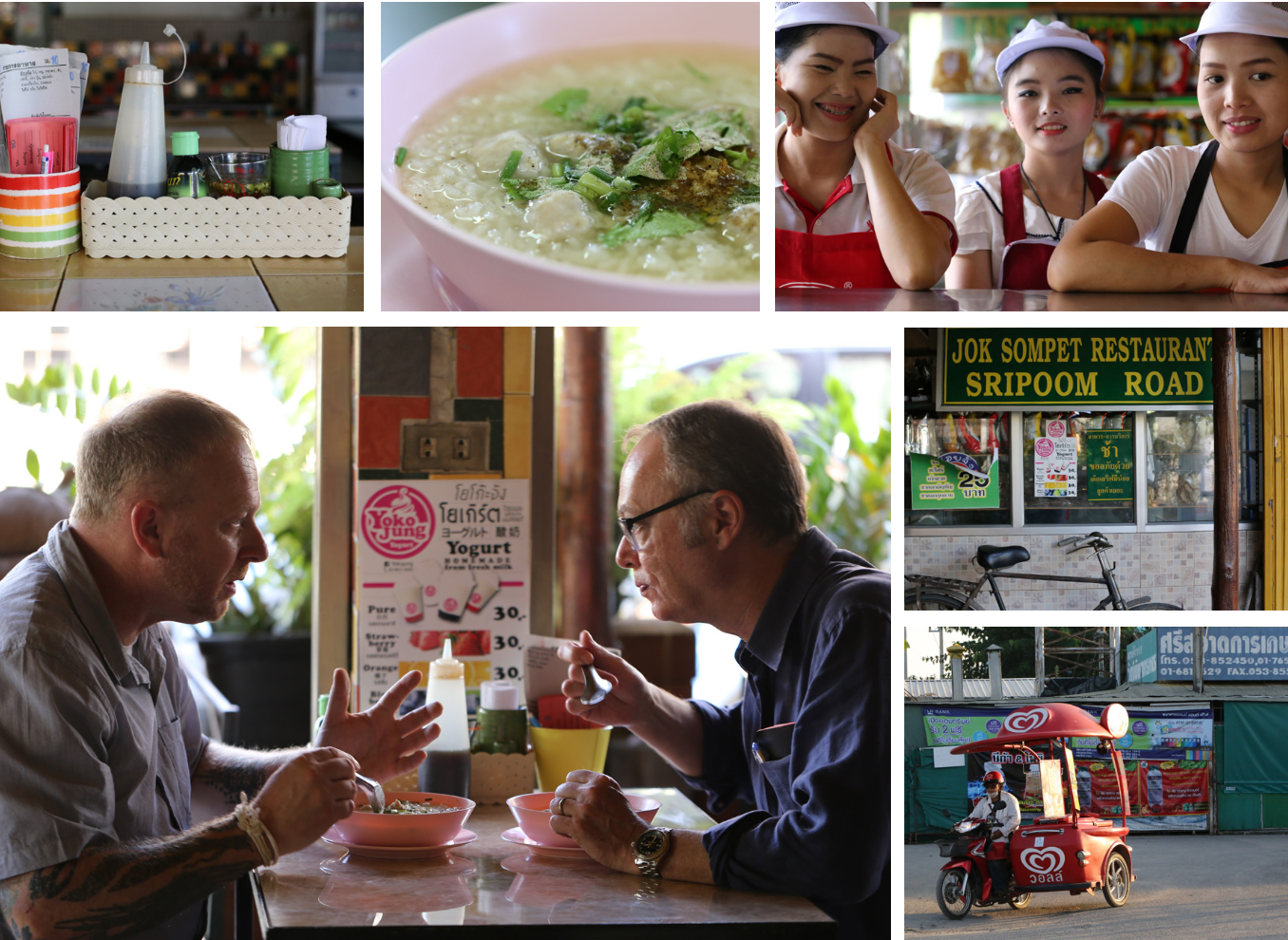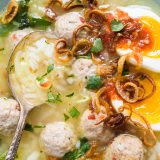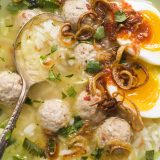Jok Sompet in Chiang Mai, Road, just at the edge of the old city. The perimeter of this area is defined by a brackish moat encircling crumbling fortress walls, the best-restored of which is the Tha Pae Gate, a popular spot for a wedding photo, which is most often snapped during an induced lift-off of flapping pigeons (a gambit that adds extra visual interest).
This unassuming 24-hour restaurant—“jok” means rice porridge and “Sompet” is the name of a nearby market—sits next to the chaotic bustle of three-wheeled taxis, small delivery vans, bicycles and pedestrians who make an art out of crossing the busy street without turning into a statistic.
Inside, however, quiet descends, and my well-versed culinary guide, Andy Ricker, owner of the Pok Pok restaurants in the U.S., introduces me to the chef-owner and the rest of the staff with the usual “wai,” the prayerful upholding of hands. English is not spoken, so the universal language of cooking—plus Andy’s translations—are in demand.
My mission: to learn the recipe for Thai rice soup, or khao tom.
In Chiang Mai, a restaurant is usually one large room with an open kitchen taking up one corner. One wall is often open to the elements, and the accommodations—tables and chairs—are purely functional. On each table sits a small jar of green chilies in vinegar (a condiment most often found in noodle shops and “jok joints”), chili powder, soy sauce, Maggi Seasoning and nam prik, a tangy chili sauce. Spoons and forks—no knives—sit flat in a small metal box. Chopsticks, though not a common item in Thailand, are available here, as Jok Sompet also serves dim sum.
A large pot of simmering pork stock and an enormous floor-mounted rice steamer—larger than a beer keg—are at the ready. The cook ladles stock, a helping of rice and small pork balls into a battered 3-quart saucepan, heats it for two minutes, then ladles half the soup into bowls. She adds a coddled egg to each bowl and more hot broth. The bowls are finished with fried garlic, white pepper, soy sauce, cilantro, scallions, ginger and salted radish.
The first spoonful tells the story, providing a full range of sensations, from bright (ginger) and pungent (soy sauce) to peppery, garlicky, fresh (scallions and cilantro) and rich (egg), all wrapped around the soft savoriness of pork meatballs. It is a world of tastes and aromas, all against a simple backdrop of broth and rice. Brilliant.

Back at Milk Street, we started with the rice. We found that cold rice worked best since it holds its texture, making the soup less viscous. In a pinch, make rice and cool it (spread it onto a baking sheet, let it come to room temperature, then pop it in the refrigerator).
Jok Sompet starts with its own broth; we had to flavor commercial chicken broth. We sautéed shallots in lard (coconut or even a neutral oil will work), then added garlic, lemon grass and ginger for just 30 seconds. The chicken broth went in next and simmered for 15 minutes.
We considered adding ground sautéed pork instead of meatballs, but the texture of the latter was better. Ground pork was mixed with fish sauce, chili-garlic sauce and white pepper, then formed into meatballs by hand or with a small ice cream scoop.
The lemon grass was fished out of the cooked broth, then the meatballs were added (they cooked in under 5 minutes), and finally the rice, which heated up in just a minute. Off heat, we boosted the flavors with more fish and chili-garlic sauce, a full cup of cilantro, lime juice and white pepper. Fried shallots, a common condiment in Southeast Asia, added a sweet, salty finishing touch.
As for the egg, some recipes call for a raw egg, which cooks in the hot broth. Jok Sompet uses coddled (very softly cooked) eggs, but we decided on simple soft-boiled eggs.
The concept is simple, but this is Thai cooking at its best: a savory base punched up with a variety of flavors (lime juice and shallot, fish sauce and ginger, lemon grass and white pepper), plus the contrasting textures of soft-boiled egg, fried shallots, pork meatballs, rice and broth. This is a cooking lesson in a bowl.
Thai rice soup requires cooked and cooled rice; in hot broth, freshly cooked rice will swell and turn mushy. Cook the rice before making the soup, spread it on a baking sheet to cool to room temperature, then chill in the refrigerator. Or prepare rice well in advance, scoop it into zip-close bags and pop them into the freezer. Frozen rice keeps for up to a month and can be added directly to the soup. It's also perfect (once thawed) for fried rice.





